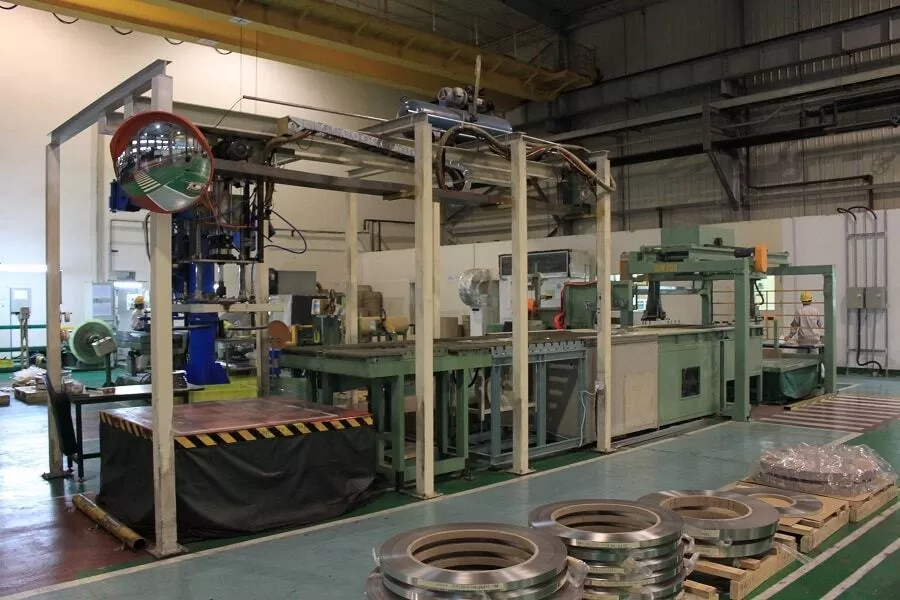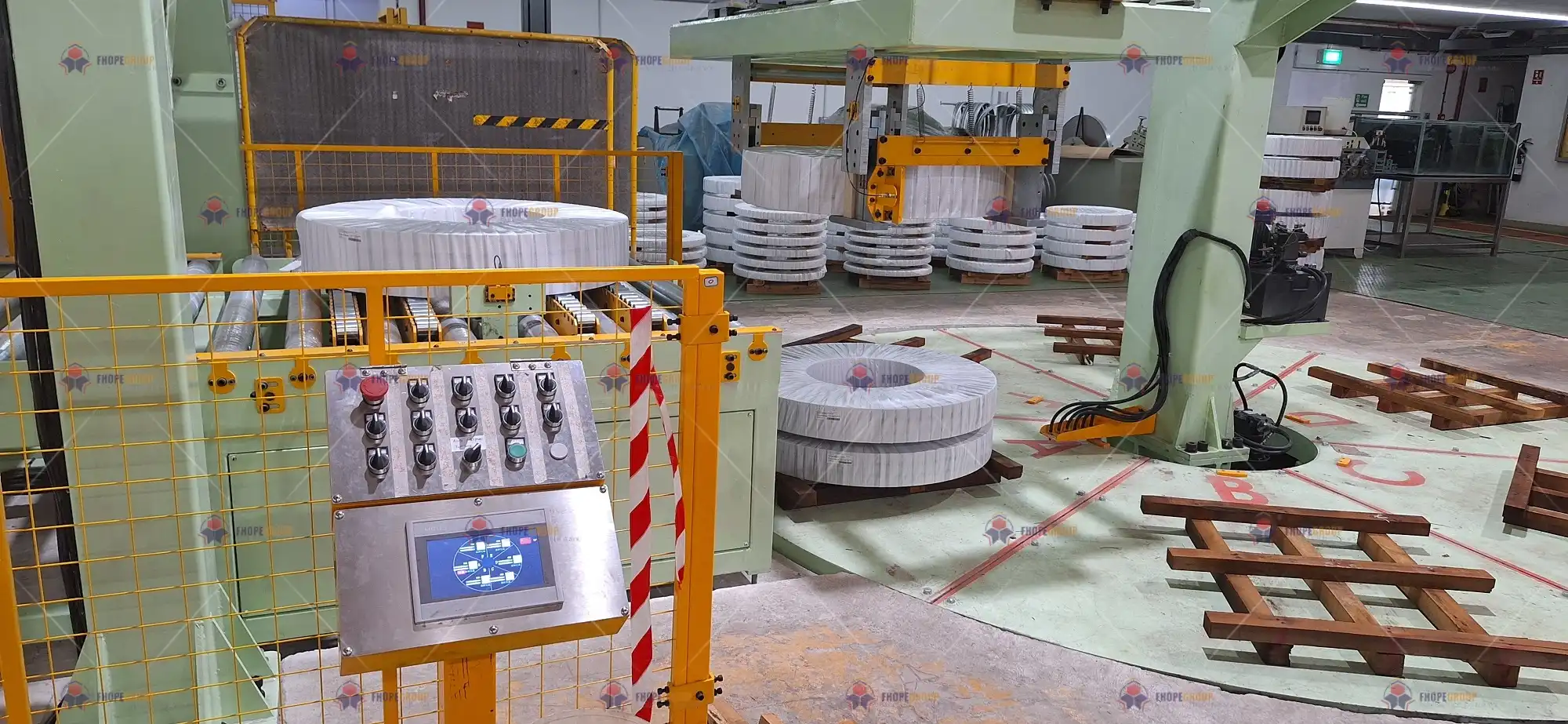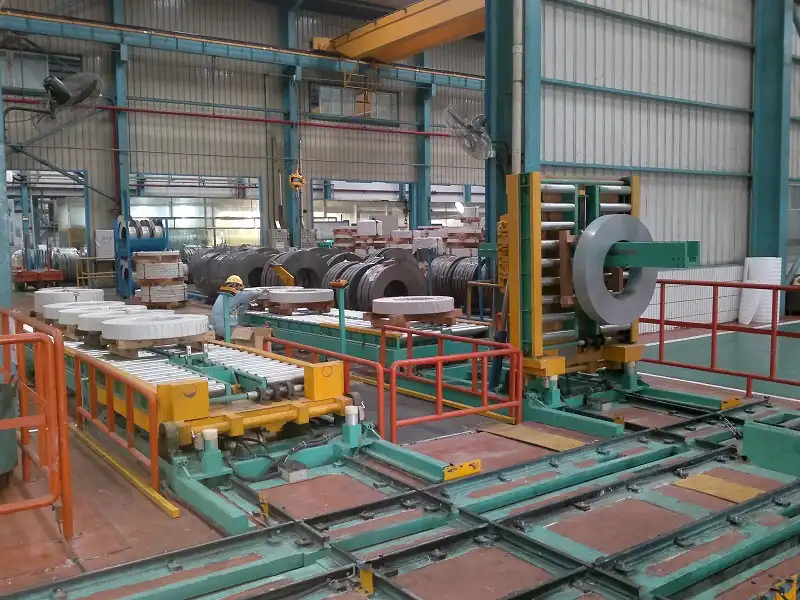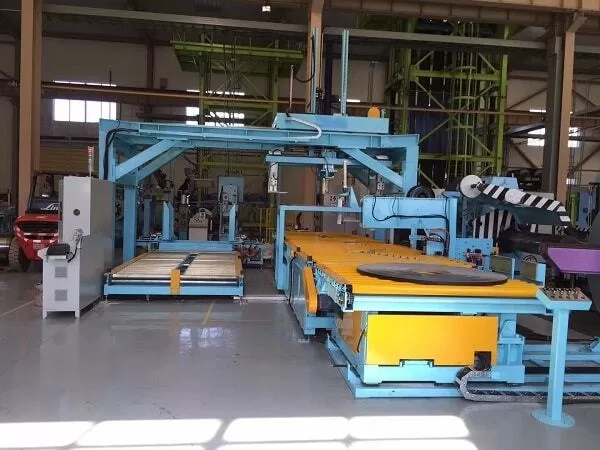Setting up a new operation in a location like Vietnam presents a unique set of challenges and opportunities. You're under immense pressure to get your plant running efficiently while keeping a close eye on the budget. When it comes to your coil packing line, the temptation to choose the cheapest option is strong. But I've seen this story play out many times. A low initial price can quickly turn into a nightmare of breakdowns, damaged products, and soaring maintenance costs, completely wiping out any initial savings. You need a solution that works not just on day one, but for years to come. This isn't about finding the cheapest machine; it's about making the smartest investment. Based on my journey from a machine engineer to a factory owner, I want to share a practical framework for building a packing line in Vietnam that is truly cost-effective over its entire lifespan.
To build a cost-effective coil packing line in Vietnam, you must focus on a balanced approach that optimizes your total cost of ownership. This involves strategically selecting semi-automatic machines to leverage local labor costs, investing in high-durability core components to minimize long-term maintenance, and ensuring the line is designed with modularity to accommodate future growth without requiring a complete and expensive overhaul.

That initial quote for your packing line is just the tip of the iceberg. The real cost of a machine reveals itself over 10 to 15 years of operation. It’s measured in uptime, maintenance bills, energy consumption, and flexibility. A truly cost-effective line is a strategic asset that contributes to your bottom line, rather than draining it. So, let’s move beyond the price tag and dive into the specific strategies that will ensure your investment in Vietnam is a profitable and stable one. We'll start with one of the most critical decisions you'll make.
How do you balance automation and manual labor in Vietnam?
Deciding on the right level of automation for your Vietnam plant can feel like a major headache. On one hand, full automation promises consistency and speed, but it comes with a very high upfront investment and requires a highly skilled maintenance team. On the other hand, relying too heavily on manual labor can lead to inconsistencies in packaging quality, potential safety hazards, and challenges with training and turnover. Making the wrong choice can be costly. You could be stuck with high fixed costs in a market that demands flexibility, or you could be struggling with quality control issues that damage your reputation, especially as labor costs in Vietnam continue to evolve. The solution isn't to choose one extreme over the other. The most effective strategy for a plant in Vietnam is a smart, semi-automatic approach. This method combines the precision of key automated machines with the flexibility and cost-effectiveness of manual labor for less critical tasks.
The best way to balance automation and manual labor for a coil packing line in Vietnam is to automate the critical, repetitive, or hazardous tasks, such as the wrapping cycle and strapping application. You should then use manual labor for more variable tasks like loading packaging materials, applying final labels, and initial coil loading with hoist assistance. This approach keeps the initial investment low, maintains operational flexibility, and maximizes the strengths of both machines and people.

Breaking Down the Semi-Automatic Approach
A semi-automatic line is not a compromise; it's a strategic choice tailored to the economic and operational realities of markets like Vietnam. I've worked with many clients in Southeast Asia who initially wanted a fully automated, "lights-out" operation. Some went ahead and bought one from other suppliers. They quickly found that these complex systems were difficult for their local teams to maintain and troubleshoot. A simple sensor failure could halt production for a full day while they waited for specialized support. They had an expensive, high-tech line that was often sitting idle. A simpler, more robust semi-automatic line would have delivered far greater output and a much better return on investment.
Core Tasks to Automate
Your automation budget should be focused on areas where precision and repetition are key to quality and safety.
- Orbital Wrapping: This is the heart of the process. An automated wrapper ensures a consistent, tight, and professional-looking package every time. It eliminates variations that occur with manual wrapping, which can lead to moisture damage or physical scuffs during transit.
- Strapping: Automated or semi-automated strapping provides consistent tension, protecting the coil and the packaging film. This is also a safety-critical task, and automating it reduces risks to your workers.
- Conveying: Using powered conveyors to move heavy coils from one station to the next is essential for safety and efficiency. It sets the pace of the line and removes a major physical bottleneck.
Smart Roles for Manual Labor
Leverage Vietnam's labor advantages for tasks that require flexibility and intelligence.
- Coil Loading and Unloading: While the main transport is automated, the initial placement of a coil onto the line via a C-hook or crane, and its final removal, is often done more cost-effectively with a trained operator.
- Material Replenishment: An operator can easily reload rolls of stretch film or steel strapping. Automating this adds significant cost and complexity for a relatively simple task.
- Quality Control and Labeling: A final visual inspection by a person is invaluable. They can spot issues that sensors might miss. Applying complex labels or documents is also a perfect job for an operator.
Here’s a clear comparison for a Vietnam plant context:
| Feature | Fully Automatic Line | Semi-Automatic Line (Recommended) | Fully Manual Operation |
|---|---|---|---|
| Initial Investment | Very High | Medium | Very Low |
| Labor Cost | Low | Medium | High |
| Maintenance Cost | High (Requires specialists) | Low (Simpler mechanics) | N/A |
| Package Quality | Very Consistent | Consistent | Inconsistent |
| Flexibility | Low (Hard to change) | High (Easy to adapt) | Very High |
| Suitability for Vietnam | Risky | Ideal | Inefficient for volume |
By adopting a semi-automatic philosophy, you build a resilient, productive, and cost-effective line that is perfectly matched to your operational environment.
What are the key machines that define a line's long-term cost?
When you look at different proposals for your packing line, many of the machines might look similar on paper. It's incredibly difficult to tell where you should invest more for long-term reliability and where you can afford to save a little. The problem is, a decision to save a few thousand dollars on a critical component today can lead to a disaster tomorrow. Choosing a machine with a cheap, unknown brand of motor or a low-quality PLC control system can result in constant production stops, frustrating downtime, and expensive emergency repairs. These seemingly small component choices can cripple the efficiency and profitability of your entire line. Over my career, I've learned that focusing your investment on three core areas is the key to building a line that runs smoothly for over 15 years. The main wrapping engine, the control system, and the conveyor system are what truly determine your total cost of ownership.
The key machines and components that define a packing line's long-term cost are the orbital wrapping machine, the strapping machine, and the conveyor system. Specifically, investing in high-quality, globally recognized brands for motors (like SEW or Siemens), reliable PLC/HMI systems (like Siemens or Allen-Bradley), and robust, heavy-duty conveyor frames and rollers will dramatically reduce downtime, maintenance expenses, and operational headaches over the equipment's lifespan.

Diving Deeper into Core Component Choices
Think of your packing line like building a house. You can save money on paint, but you must not cut corners on the foundation. For a packing line, the motors, controls, and steel structure are your foundation. A client once insisted on saving about $5,000 by allowing a supplier to use a no-name PLC from a small, unknown factory. The sales pitch was that it had the "same functions." Six months after installation, the PLC failed. It took them three weeks to get a replacement from the original supplier because no one else had it. The production losses were over $100,000. That was a powerful, and expensive, lesson about the value of quality components. Let's break down where to focus.
The Orbital Wrapper: The Heart of the Line
This machine does the most critical work. Its reliability dictates your line's throughput.
- The Ring and Drive System: The large ring that carries the film must be made from solid, precision-machined steel or cast iron, not welded plate. The drive system should use durable polyurethane friction wheels and a reliable motor with a proven gearbox. A cheap system will wear out quickly, causing vibrations that lead to film breaks and poor-quality wraps.
- The Film Delivery System: Look for a powered pre-stretch unit. This system can stretch the film by 200-300%, which significantly reduces your film consumption costs. A cheap wrapper without this feature might have a lower purchase price, but it will cost you far more in packaging materials every single year.
The Control System: The Brain of the Operation
This is where reliability is paramount. Downtime is often traced back to faulty electronics.
- PLC (Programmable Logic Controller): Insist on mainstream, globally supported brands like Siemens, Allen-Bradley (Rockwell), or Mitsubishi. If a problem occurs, you can find support and spare parts in or near Vietnam. A proprietary or obscure PLC brand makes you 100% dependent on the machine supplier for support, which can be slow and expensive.
- HMI (Human Machine Interface): This is your operator's main control point. It should be intuitive, clear, and available in the local language or English. A good HMI provides clear error messages, making troubleshooting fast and easy. A poor one just shows a generic "Fault" code, leaving your team guessing.
The Conveyor System: The Backbone
A conveyor seems simple, but a weak one is a constant source of problems.
- Frame and Rollers: The frame must be built from heavy-duty structural steel, not thin, bent sheet metal. The rollers should be thick-walled and use high-quality, sealed bearings. Under the weight of steel coils, cheap rollers will bend and their bearings will fail, causing the entire line to jam.
- Motors and Gearboxes: Each conveyor section should be powered by a high-quality motor and gearbox from a reputable brand. Undersized motors will overheat and fail prematurely under the strain of starting and stopping heavy loads.
| Component | Budget Option (High Risk) | Quality Option (Smart Investment) | Long-Term Impact of Quality Choice |
|---|---|---|---|
| PLC/Control System | Obscure, proprietary brand | Siemens, Allen-Bradley, etc. | Reduced downtime, easy local support |
| Wrapper Drive Motor | Unknown brand, lower efficiency | SEW, Siemens, NORD | Lower energy costs, higher reliability |
| Conveyor Frame | Light gauge, bent steel | Heavy structural steel (H-beam) | No bending, longer life, safer |
| Conveyor Bearings | Unsealed, generic | Sealed, SKF or similar | Less maintenance, no jamming |
Investing in these core areas is not an expense. It is the single best way to reduce your long-term operational costs and ensure your Vietnam plant runs like clockwork.
How can you future-proof your packing line from the start?
You are building a packing line to meet your needs today, but business is never static. What happens in three or five years? Market demand for different coil sizes might change. Environmental regulations on packaging materials could get stricter. You might want to integrate your factory floor with a new MES system for better data tracking. If your packing line isn't designed with the future in mind, you risk being trapped with an obsolete system. Making changes later could require a hugely expensive and disruptive overhaul, leaving you at a competitive disadvantage. But by making a few smart, low-cost decisions now—focusing on modular design, ensuring data connectivity, and demanding material flexibility—you can build a line that adapts and grows with your business. This protects your initial investment and turns it into a long-term strategic asset.
To future-proof your coil packing line, you must insist on three things from your supplier. First, a modular design that uses standardized sections, which allows for the easy addition or replacement of stations later. Second, a control system (PLC) that uses open communication protocols, like OPC-UA or Profinet, to ensure it can connect to future MES/ERP systems. Third, machines that are mechanically adjustable to handle a wider range of coil dimensions and packaging materials than you currently use.

Designing for Tomorrow's Challenges Today
When I started my own factory, I established a core principle for every machine we designed: build for what the customer will need tomorrow, not just what they ask for today. One simple thing we did was add extra, unused input/output (I/O) ports to every PLC we installed. It cost almost nothing extra during the build. Years later, clients would call us asking to add a new safety sensor, a warning light tower, or a barcode scanner. Because the "hooks" were already there in the control cabinet, we could help them make the upgrade in a single afternoon. This philosophy of building for the future is what transforms a simple supplier-customer transaction into a long-term partnership. It’s exactly the kind of forward-thinking a leader like you, Javier, values.
Modular Design for Physical Scalability
A modular design is your best defense against changing production needs. Instead of a single, custom-welded frame, the line is built in sections: an infeed conveyor, a wrapping station, an outfeed conveyor, etc.
- Easy Upgrades: This approach means you can easily add a new module later. For example, you can leave a physical space in the line to add a strapping machine or an automatic stacker in a few years when your production volume justifies the investment.
- Simple Replacements: If a section of the line becomes worn out or obsolete after 10 years, you can replace just that module instead of the entire line. This dramatically lowers the cost of future modernization.
Data Connectivity for Digital Transformation
Your goal of deploying MES, IoT, and data analytics is a smart one. The packing line must be ready for it.
- Open Protocols: Ensure the PLC can communicate using a non-proprietary, open protocol. This is critical. It's like ensuring your new computer has a USB port instead of some weird, custom plug. It guarantees that your packing line can "talk" to other software and systems you buy in the future.
- Data-Ready Sensors: Even if you don't need the data today, using sensors that can output more than just a simple on/off signal is a wise, low-cost investment. A smart sensor can report on its own health, providing the basis for the predictive maintenance you want to achieve.
Material and Product Flexibility
Market demands fluctuate. A line that can only handle one size of coil or one type of packaging film is a risky investment.
- Adjustable Components: The wrapper should be able to handle a range of coil diameters and widths. The conveyors should have adjustable guide rails.
- Multiple Materials: Ask if the wrapper can be easily adapted for different types of film, or even VCI paper, should your customers or regulations require it in the future.
| Feature | Fixed, "As-Is" Design | Future-Proof, Modular Design | Key Benefit for Your Goals |
|---|---|---|---|
| Line Layout | One long, welded frame | Separate, bolted modules | Allows for future addition of equipment to increase capacity. |
| PLC/Controls | Proprietary communication | Open protocol (e.g., OPC-UA) | Enables your goal of MES/IoT integration and data visibility. |
| Mechanicals | Fixed for one coil size | Adjustable guides/rollers | Adapts to fluctuating market demands for different products. |
| Future Cost | High (Requires total rebuild) | Low (Add/replace modules) | Protects initial capital and lowers total cost of ownership. |
By demanding these features now, you are making a small down payment on the future success and longevity of your Vietnam operation.
You've received a proposal for a new packing line, and the price is 30% lower than all the others. It’s a very tempting offer. It feels like an easy way to come in under budget and report a big win to your stakeholders. But my experience has taught me to be extremely cautious of such deals. That low initial price is often a smokescreen, hiding a mountain of future costs that will surface long after the purchase order is signed. I'm talking about the real costs: sky-high energy consumption, proprietary spare parts with long lead times, poor technical support, and inadequate training. These hidden expenses can quickly make your "cheap" line the most expensive and frustrating piece of equipment you will ever own. After years of being called in to fix problems on machines from other suppliers, I've learned to scrutinize a proposal far beyond the price tag. I want to show you exactly where to look to uncover these hidden costs before you commit.
The most significant hidden costs of a cheap coil packing line are not on the invoice. They include high energy consumption from inefficient motors and drives, extreme dependency on the supplier for expensive proprietary spare parts, inadequate technical documentation and training that leads to operator errors and slow repairs, and poor or non-existent after-sales support that results in extended and costly production downtime.

A Checklist to Uncover the Real Cost
I remember a conversation with a CEO in Mexico, a sharp and experienced leader much like yourself, Javier. He had purchased a low-cost packing line from a competitor to save money on a new project. The line ran, but just six months into operation, a small, non-standard gearbox on a main conveyor failed. The supplier had no local service presence and quoted him a six-week lead time for the replacement part to be shipped from their factory. His entire packaging output was stopped. He was losing thousands of dollars a day. He called my company for help. We ended up sending an engineer to his plant to re-engineer the mounting plate on the conveyor so it could accept a standard SEW-Eurodrive gearbox, which we helped him source locally in just three days. He learned a very hard lesson that day about the true, painful cost of a "bargain." To avoid this, you need to investigate these four areas.
Hidden Cost 1: Energy Consumption
This is a silent killer of your profit margin, directly impacting your goal to reduce energy costs.
- What to Look For: Ask for the power rating (kW) and efficiency rating (IE class) of every single motor on the line. An IE3 or IE4 efficiency motor might add a small amount to the initial cost but will save you thousands of dollars in electricity over its lifetime compared to a cheap, inefficient IE1 motor. Multiply that by the 10-20 motors on a typical line, and the savings are substantial.
Hidden Cost 2: Spare Parts and Support
This determines how quickly you can recover from a breakdown.
- What to Look For: Demand a list of all major components (bearings, sensors, motors, pneumatic valves) and their brands. Are they standard, internationally recognized brands like SKF, Siemens, Festo, and Omron that can be sourced in Vietnam? Or are they obscure or custom-made? A red flag is a line where more than 10% of the parts are proprietary to the machine builder. Also, ask for a price list and lead time for a recommended two-year spare parts package. Their answer will tell you a lot.
Hidden Cost 3: Documentation and Training
Poor documentation turns a 1-hour fix into a 2-day shutdown.
- What to Look For: A good partner provides a comprehensive documentation package. This must include detailed and clearly labeled electrical schematics, pneumatic diagrams, mechanical drawings, and a full parts list with manufacturer part numbers. The operator and maintenance manuals should be well-written in clear English. Insist that on-site installation and training for both operators and your maintenance staff are included in the price.
Hidden Cost 4: The Supplier's Business Model
Is the supplier trying to make a profit on the machine, or on your future problems?
- What to Look For: Some manufacturers sell machines at a very low margin, intending to make their profit from inflated spare parts prices and expensive service calls. A true partner, however, aims to sell you a reliable machine that won't require constant support. They make their profit by earning your trust and future business. Ask them about their support policy and if they provide remote diagnostic help.
| Hidden Cost Area | Red Flag (High Long-Term Cost) | Green Flag (Smart Investment) | Impact on Your Goals |
|---|---|---|---|
| Energy Consumption | No motor efficiency data provided; uses IE1/IE2 motors. | All motors are IE3/IE4 efficiency class. | Directly supports goal to lower unit energy consumption by 10%. |
| Spare Parts | Supplier uses many proprietary, unbranded components. | Uses standard parts from Siemens, SKF, Festo, etc. | Improves equipment uptime towards your 95% utilization target. |
| Documentation | Poorly translated manual with no schematics. | Full set of electrical/mechanical drawings and manuals. | Reduces downtime and maintenance costs, improving overall profit. |
| After-Sales Support | Support is only via email with 24-hour response time. | Includes on-site training and remote PLC diagnostic support. | Ensures operational stability and a true partnership approach. |
Looking beyond the price and using this checklist will protect your investment and ensure you partner with a supplier who is committed to your long-term success.
Conclusion
A cost-effective coil packing line is a strategic asset. By balancing automation, choosing quality core components, and planning for the future, you build long-term profitability and operational stability.




